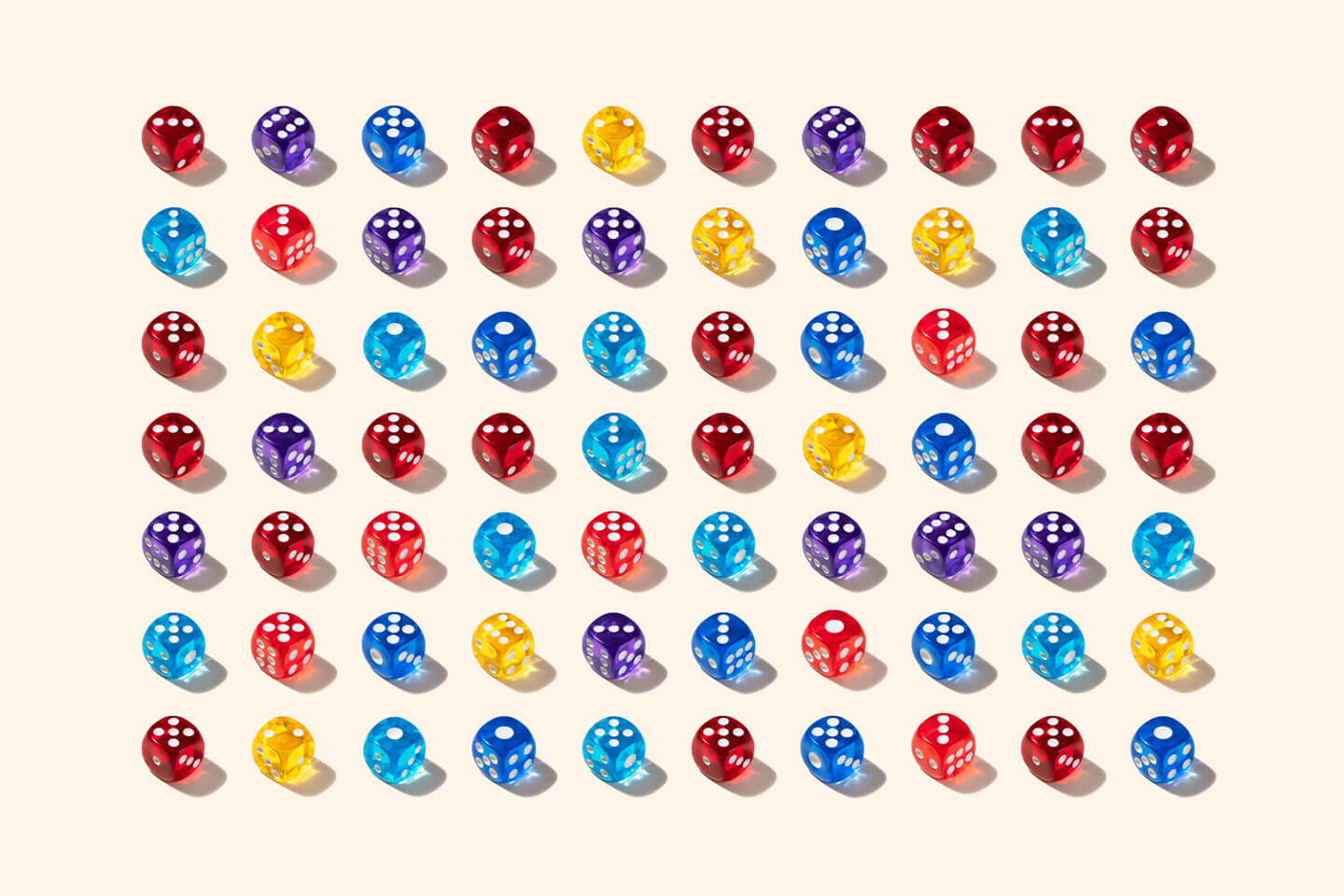In March 2023, the Pearson Math & Stats team had the pleasure of speaking with Lone Star College–Kingwood Mathematics professor, Mari Menard. In the conversation below, hear how she came to teach math after a failed attempt at Medical Tech school, and a few other lessons regarding teaching higher education that she has learned over the years. She also talks a little about the features in MyLab Math she likes the most, and why she changes things up every semester. We hope you enjoy the conversation.
Pearson Math & Stats Team:
What made you want to become an instructor?
Mari Menard (MM)
That's the funniest thing. When I first started my career, I thought, “I’m out of high school, what now?” I was going to go into the medical field, and what I soon found out, it wasn't for me. Some of the classes I was going to have to take over again. So, I dropped out and decided to come back to college a year later. My mom was the one who told me to do math. However, I could not multiply in grade school, as I had to go to what they called Resource Math. And only there did I learn how to multiply.
So, when I went back to school, my college advisor asked me if I had taken trig or any of the other classes. I told him, “No, I don't really even know what trig is”. His feeling was, “Well, then that is where we are going to start. And if you don't do well in calculus, then I need you to really rethink your degree plan.” So, right there I thought to myself, I'm going to show you. I am going to really show you.
From there, two main things happened. First, he ended up being my calculus instructor (and there were several other classes I took with him). Then, second, when I was in my graduate degree program, I graded for his calculus students, which was was interesting. As I was working, we learned (especially in calculus), it's a good idea to get a group of people together to study. Inevitably, I would be the one that would be at the chalkboard. I was answering the questions and the students that were there to study would be the ones asking me questions. And well, I was thinking I am pretty good at this. At first I had thought I would be at a high school. But then I was like, “You know, no, I don't really think I want that.” And so I've never taught anywhere but in college. (laughs)
I like to say I've never left college since I returned in 1992. I always say people retire after they teach and they still end up teaching. I think my main thing was when I was helping other students when we were studying Cal 1, Cal 2, Cal 3...all the way through differential equations...I was the one always at the board working the questions and answering questions.
Good
Pearson:
Go back to before you became an instructor. What in life led you to want to do med school?
MM:
So the degree plan was called ‘medical technology’, and I was studying to be a Medical Technologist. I'm not sure if you know what those are, but I worked in a lab at a hospital. My mother's a nurse. My brother's a nurse. My brother-in-law is a nurse. So, people in my family were in the health field and I loved working in the lab. I was a phlebotomist for several years. I drew people's blood in the hospital. So, the person in charge of the laboratory where the blood and other bodily things go is the Medical Technologist. They do lab work, microbiology, and things like that. I thought, well, that sounds like me. I would love that. So, I was working in the lab and I come to find out there's certain things I cannot handle, and one of them is mucus. Mucus and I do not get along. (laughs)
This is one thing a lot of students don't realize; you should get involved in the career path you're thinking about. I was so happy I did because I saw how the lab worked. And it wasn't just these random blood samples and people, you know, it was people's bodily fluids coming our way. Or from people that, for example, lost a leg; there would be body parts. And the smell of formaldehyde. And if you can't handle that stuff, then the lab is not the place for you. And that's how I soon learned it was not the place for me.
Pearson:
That's great. Thank you for indulging us.
MM:
Oh no, that's perfect, because people wonder, “how do you go from one to the next?” But it is also why I have a minor in biology. (laughs)
Pearson:
What courses are you currently teaching, and are there any that you've taught in the past that you don't teach now but want to teach again? Or are you kind of good with where your career is taking you and these are the ones that you enjoy the most?
MM:
I think so. I've only taught at the college level before, never at a university, and always at a 2-year college. I lead into that because most of your colleges were just on the freshman and sophomore level math anyway. So, when the developmental education thing was going on that was when I started, and am now in my 22nd plus year of teaching.
I used to love teaching pre-algebra because they (students) would follow me. So, I would teach pre-algebra, and then they would follow me to introductory and intermediate college algebra and so on. And you can see them growing and doing well.
In Texas, we now have corequisites, and it's six courses total, and they're taking two math classes. Which means, developmental math students are taking their developmental math class and their credit level class at the same time. They're trying to do math in both classes. And if they don't understand, the developmental course should be first so that it helps them with the credit level. So, I like corequisites and the credit level, provided it's a cohort of students. I could have students like I have in a credit level business math class. I have corequisite students in there, but I also have students that don't need corequisites, so it's called ‘co-mingled’.
But, currently, I teach what we call business math. I love it. It's by far one of my favorite classes to teach. It was the hardest to find corequisite content for because you want to find word problems since they encounter a lot of word problems in that class.
And I'm currently back teaching trig and precal, which I love too. We're going to do trig identities next class. I said I can do these forever. I could do every trig identity that I come across and still do more because I like them so much. And the students often say that’s not good because if you like it, then we know we're not going to like it. But, I’m thinking you don't know that.
The one (course) I wish I taught that I haven't taught in a while is the business calculus class. But I guess the best way to say the reason for that is the students. They don't appreciate what that class shows. It shows the whole purpose of business. It doesn't just get into the revenue and the cost and all that stuff, but it shows what happens as things change. Just tiny little changes and what it can do to the business. But for a lot of students, unfortunately, I don't know if it has to do with COVID or just with all the technology that’s available, they just say why can't we just use our calculator? And, well, your calculator can't tell somebody if the slope is negative, and what that means in the context of their business. If you're saying, “Oh, I'm good, but your cost is constantly going up, and if your profit is constantly going down, how are you good? And if you don't even understand the difference between revenue, cost and profit? Then how are you good?” And so, yeah, I try to get them in the finite class. By that I mean the math for business class before they get to the business calculus class so that they have the understanding of how important it is regarding all these aspects of it. And it is a word problem which they hate. But life is a word problem. (laughs)
Pearson:
What is one best practice that you use that you think works really well and you would want to share with others, whether it's in a classroom setting, working in groups, or working one-on-one with a new teaching technology?
MM:
It's kind of funny because every semester I change things, which I guess is one of my best practices. I'm always asking for student feedback. Not how I teach, but what I use in terms of resources or what I use to calculate their grade. So, here’s an example...
Previously, I used MyLab Math homework as a bonus option. The minute students hear bonus they think, “oh, I don't have to do it!” So, then none of them were doing anything. Of course, when they take a test they wonder [if there’s any bonus point opportunities], but by then it's kind of too late.
Last semester I used homework as a bonus, where I had discussion boards in our online learning platform as a graded assignment in the face-to-face class. And one of my students at the end of the semester said it makes no sense that we're doing a discussion board and a face-to-face class. I asked them, “what if I use it as bonus?” And she said, ‘’yes, because then it's something that's not going to hurt us. It can only help us.” So I asked her, “what about the homework?” And she replied, “that's the stuff you need to grade, because if we don't know what we're doing, then by the time we take the test or do the practice test or do quizzes and MyLab Math work, then we haven't learned anything.” She, of course, was a student that did really well. She was doing all of the things, you know. But I even had students that didn't do the homework, so the homework needs to be part of the grade.
And I thought, “Hmmm, how do I do that?” So, I made homework for some of my sections but not all. When we teach 30 sections, you can't have homework for every section. I usually base it on anywhere between two and five sections; it just depends on the course. I designated MyLab Math homework for one, and then I tell them it's over sections, let's say sections one through five. I provide the media options (which I love by the way) and then there's questions that they'll work on. What I tell them is if you can't do these and I have to help, I will turn the example off, because I think they just try to find a shortcut way to compare them and then just put the answer in there. I also tried giving them an unlimited number of times for each question, which I've determined was not a good thing.
Students love to circumnavigate me, and try to find an easy way to solve what I've done. So what they're doing, I fully believe is, they're just hitting the reiterations until they see a question they've already done and they're not really learning it. They're just trying to regurgitate it. Which isn't going to help them. And this is why I'm still getting students making hundreds on the homework but making a 20 on my test.
I think then my best practice is realizing that change is not a bad thing. I always tell people I learned that through COVID. Change is never bad, especially if it's going to improve things. Or not necessarily improve, but enhance what I already do.
Pearson:
Do you feel the pandemic helped students, that they think more conceptually, and that you are able to use content like the pandemic within the classroom and relates it to their day-to-day, and how? Also, was there an increased interest in that topic or were you caught up in noticing that there were a lot of students falling behind?
MM:
Unfortunately, I think that's what happened. So, I just had a test last week and I have never had what happened happen before. I think it was five students, and with three of them, the minute they saw their test, they were like so when am I going to be able to do a retest? One of them e-mailed me and said they weren't feeling well. They wanted me to send the test. I guess so he could take the test at home? I think some of that behavior has come out of COVID, in terms of what students expectations are, and I like to say what they can get away with. I think they're relearning just as we are.
Like now, for me, I am much more mellow about things like the student that wanted me to e-mail him the test so he could take it home. I laughed for a full day. I mean, I just laughed. Because, who does that? I mean, who does that?! Essentially, he wanted me to e-mail him the test so he could take it, and this was a trig student. So after I laughed about it, I referred him to the syllabus and how I offer makeups, and that you can take the makeup test at the testing center here at the college. The test was on Thursday and I gave him through yesterday to take it again. But, I haven’t heard back from him, and he didn't come to class today. Oh, and another student, he slept through the exam. So, you know... (laughs)
So, is it that the students have really changed? I don't think so. I've experienced all kinds of things in the 20 years I've been teaching. But are they a little more interesting as to what their expectations are? Definitely! Where are they getting this idea they can do retakes? Well, I fully believe that that's what happened in high school. Because they were just trying to make it through high school, you know, and I understand that. But it's now college and I've even learned some of the universities now are going back to what it was like pre-COVID. And it's taking some of the other colleges a little longer.
Pearson:
In your opinion, what is higher education going to look like in the next two to three years? Is it a little bit of revisiting the past moving forward, while also trying to reuse what you've learned about what their expectations are around bonus work, regular homework, test retakes, etc.?
MM:
My thing is if they want to take a test at home, then take an online class. Some instructors are allowing students to take tests at home. But for me, I have an online trade class. Their tests are all taken through MyLab Math. There's no testing center. They can take it through a date range. You have to submit your work, as there are regular expectations. So moving forward, I'm not stuck on if this is how I'm going to do it for the rest of my career scenario. But, again, I'm constantly changing, which I think is stupid on my part sometimes because then I have to work at things every semester. (laughs)
Currently, I have no videos to use, which is irritating me a little. At the moment, I am just using publisher videos, such as Pearson's videos and all the other things that students have resources for. I had planned on doing that, making videos and everything but... This semester there's been no time between fall and spring. So, am I going to make some videos over the summer? Heck yes I am!
But for me, it's always just actively asking students how things went. I think I have things set up pretty good in terms of this is one of my favorite things. I've learned to say certain things to students because students will say, “when am I ever going to use this?” And I say, “let me just tell you. In this world, we all usually will have a job, and the requirements of your job are pretty clear.”
So for me, my expectations, are that when you continue on, if you need to learn whatever it is I'm supposed to teach you in this class, you've got it. But, I also want to make sure that I teach student learning outcomes. So you may not like linear programming or probability or set theory or trigonometric in identities. But, it's my responsibility to teach you. I'm going to do that to the best of my ability. I provide you with things to help you along the way, learning from videos, lectures, and notes. I have booklets. I have PowerPoints. I have all the things, you know, homework, and quizzes, to see how things go. And if you have that learning, then I will put down a check mark and I'm doing my job. Then I can move on.
Pearson:
Finally, are there two or three big things you think everybody should use or the reasons you use it? Such as the videos you were talking about creating yourself and having those inserted into the lesson(s), or is that something you would like to be able to do so that it's interchangeable with the content that Pearson provides?
MM:
I love the ability to change or to do what I want to with MyLab Math.
For instance, I insert my logo, which some say who cares? The college, you know, they're making my theme, the colors, the layout and changing the names of things, integrating it with our learning management platform and all the resources. So, one of the ones that most folks, and they call it different things based on the publisher, but they'll have guided notes or something like that. I've actually taken them and made them my own. So, I still put Pearson on the bottom, and I also use the Beecher Book, and I use the precal Sullivan book.
Students don't need a whole bunch of stuff. Sometimes the problem is they get too much stuff. They'll go out and find YouTube, Khan Academy, and various other things to try and learn one thing. And so now they've seen it five or six different ways. And I wonder how is it helping you? That's just going to confuse you. So I have Pearson. Nice and sweet. I’ve got somebody's other way in which to do it, and I have my way. From there, I include a quiz within it. So, I like that idea! Then Pearson is a just a great resource scenario, such as the pooling option. Don't get rid of the pooling option! (laughs) That by far is my favorite things. I do a practice test and their test, and I believe there's a strong correlation with how I have the practice test set up to the grade they actually make on my test.








